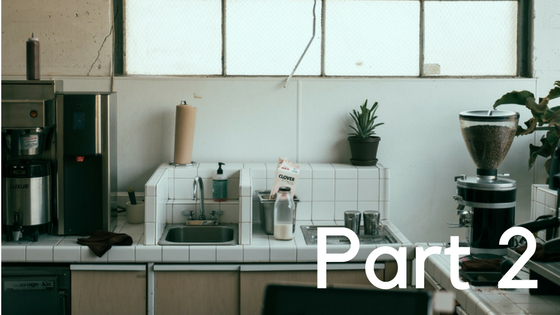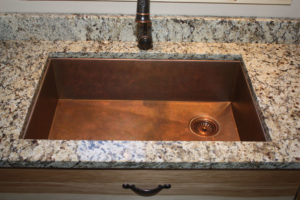If you’re finding it mind-boggling choosing your kitchen sink, let us help you out. We’ve gathered information on each type of kitchen sink and paired it with a pros and cons list so you can compare apples to apples and make an informed decision.
Read Part 1 of this series
Fireclay
Created by a liquid clay mixture poured into a mold and fired at very high temperature. A great choice if you are looking for a white or light colored sink as they are practical and easy-care. Traditionally made as an apron front/farmhouse style, but these days more manufacturers are offering wider style choices including under-mount and double-bowl.
Pros:
- It’s non-porous, hard-wearing finish is highly resistant to scratches, germs, staining and chipping
- Harder than metal and impervious to bleaches and acids
- The perfectly smooth finish is easily cleaned with dish-washing liquid
- Lighter colors will disguise water spots
Cons:
- Limited color choice of white, biscuit, linen and sometimes black
- Metal items may leave marks on the surface but they can be removed with a special cleaner. Avoid using abrasive cleaners or powders
- One of the more expensive types of sinks
- It’s hard surface means dropped dishes may break more easily
- Their heavy weight requires installation on a sturdy cabinet
Enameled Steel
These are manufactured by baking a porcelain enamel coating onto a steel base in a similar process to enamel over cast-iron sinks. These are often used to get a similar look to cast iron but with a great savings and easier installation due to the lighter weight.
Pros:
- Resistant to stains, odors and chemicals
- In the lower price range of sinks
- Easy to care for. Avoid using harsh cleaners
- Lightweight and easy to install
- The enameled finish hides water streaks in lighter colors but the darker colors may show them more
- Available in a wide range of colors and in both top and under-mount styles
Cons:
- The thinner metal steel base may dent, chip or crack more easily. Use a sink grid or protector on the bottom to avoid damage from dropped heavy objects
- If water leaks under the edge it could cause the underside of the sink to rust and corrode
Copper
Bring a unique natural look to your kitchen (or bathroom). Copper will develop a characterful patina over time that some people may love and others may dislike. Or keep the new shiny copper look by using a copper cleaner that will prevent its oxidization. Farmhouse or apron-front sinks lend themselves beautifully to this warm material.
Pros:
- Naturally anti-microbial and rust resistant
- Easy to clean using mild soap and water but avoid using harsh chemicals
- Copper can be uniquely personalized with custom design details such as hammering or patterning
- Scratches and dents will be less noticeable on a hammered sink where the patina has been allowed to develop
- The lighter weight material makes installation easy
Cons:
- Keeping the shiny ‘new-finish’ requires more upkeep. Use a copper cleaner regularly
- One of the priciest kitchen sink materials. Costs will increase even more depending on the gauge and the degree of hand-crafted detailing. Choose a minimum 16-gauge copper, but a 14 or 12 gauge will be thicker and stronger. TIP: Consider only high quality sinks of at least 99% pure copper. A small amount of zinc may be added for strength, but make sure there is no added lead.
Continued in Part 3…….



